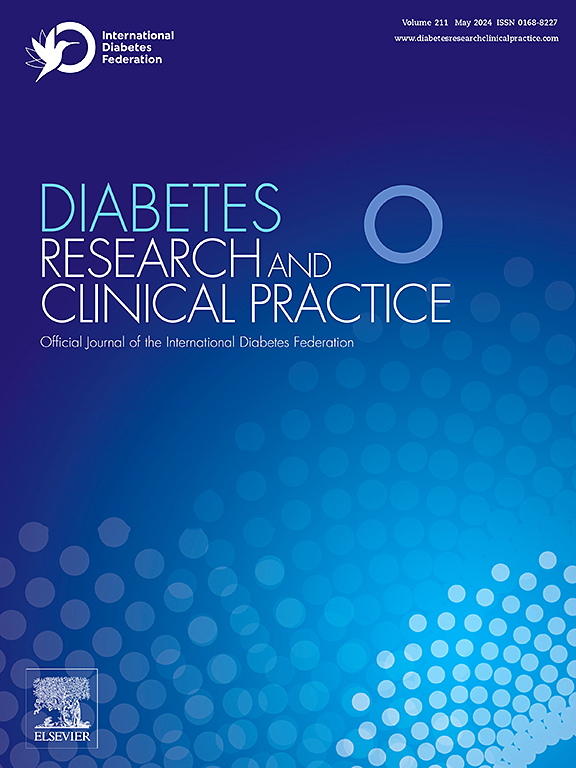Triglycerides to high density lipoprotein cholesterol ratio (TG/HDL), but not triglycerides and glucose product (TyG) index, is associated with arterial stiffness in prediabetes
IF 6.1
3区 医学
Q1 ENDOCRINOLOGY & METABOLISM
引用次数: 0
Abstract
Aims
Prediabetes (preD) carries increased risk of cardiovascular (CV) events than normal-glucose-tolerance (NGT). Insulin resistance, a hallmark of preD, is closely linked to CV-risk, making its assessment crucial. Triglycerides-to-high-density-lipoprotein-cholesterol-ratio (TG/HDL) and triglycerides-and-glucose-product (TyG) have emerged as surrogate of insulin resistance. We aimed to evaluate the association of these indexes with CV-risk assessed through arterial stiffness in preD.
Methods
377 individuals without diagnosis of diabetes underwent: (1) complete biochemistry and oral-glucose-tolerance-test; (2) CV-risk assessment through arterial stiffness (pulsed-wave-velocity – PWV – and augmentation-index – AugI) and intima-media-thickness (IMT). Participants were split according to current guidelines: NGT (n = 100), preD (n = 216), and newly-diagnosed-type-2-diabetes (ND-T2D) (n = 61).
Results
TG/HDL and TyG were higher in preD than NGT, with no difference between preD and ND-T2D regarding TG/HDL. PreD showed higher PWV, AugI, and IMT than NGT. In preD group, after adjusting for major confounders, PWV was correlated with TG/HDL (β = 0.16; P = 0.03), but not with TyG, and there was a trend of association with HOMA-IR (β = 0.19, P = 0.07). In logistic regression, being in the higher tertile of TG/HDL was associated with higher PWV (odds-ratio 2.51, 95 %CI 1.01–6.29, P = 0.048).
Conclusions
In preD, TG/HDL was independently associated with PWV, suggesting its possible role as a simple, cost-effective tool for assessing CV risk.

甘油三酯与高密度脂蛋白胆固醇比值(TG/HDL)与糖尿病前期动脉硬化相关,但与甘油三酯与葡萄糖产物(TyG)指数无关
AimsPrediabetes (preD)比正常葡萄糖耐量(NGT)有更高的心血管(CV)事件风险。胰岛素抵抗是preD的一个标志,与cv风险密切相关,因此对其进行评估至关重要。甘油三酯-高密度脂蛋白-胆固醇比率(TG/HDL)和甘油三酯-葡萄糖产物(TyG)已成为胰岛素抵抗的替代指标。我们的目的是评估这些指标与preD动脉僵硬度评估的cv风险的相关性。方法对377例未确诊的糖尿病患者进行:(1)全生化及口服葡萄糖耐量试验;(2)通过动脉刚度(脉搏波速度- PWV -和增强指数- AugI)和内膜-中膜-厚度(IMT)评估心血管风险。参与者根据现行指南进行分组:NGT (n = 100), preD (n = 216)和新诊断的2型糖尿病(ND-T2D) (n = 61)。结果preD组stg /HDL和TyG均高于NGT组,而TG/HDL在preD组和ND-T2D组间差异无统计学意义。PreD的PWV、AugI和IMT均高于NGT。在preD组,调整主要混杂因素后,PWV与TG/HDL相关(β = 0.16;P = 0.03),但与TyG无关,与HOMA-IR有相关性(β = 0.19, P = 0.07)。在logistic回归中,TG/HDL分位数越高,PWV越高(比值比2.51,95% CI 1.01-6.29, P = 0.048)。结论在preD中,TG/HDL与PWV独立相关,提示其可能是评估CV风险的一种简单、经济的工具。
本文章由计算机程序翻译,如有差异,请以英文原文为准。
求助全文
约1分钟内获得全文
求助全文
来源期刊

Diabetes research and clinical practice
医学-内分泌学与代谢
CiteScore
10.30
自引率
3.90%
发文量
862
审稿时长
32 days
期刊介绍:
Diabetes Research and Clinical Practice is an international journal for health-care providers and clinically oriented researchers that publishes high-quality original research articles and expert reviews in diabetes and related areas. The role of the journal is to provide a venue for dissemination of knowledge and discussion of topics related to diabetes clinical research and patient care. Topics of focus include translational science, genetics, immunology, nutrition, psychosocial research, epidemiology, prevention, socio-economic research, complications, new treatments, technologies and therapy.
 求助内容:
求助内容: 应助结果提醒方式:
应助结果提醒方式:


